We disassemble the Sony Xperia Z1 Compact: a small smartphone with the heart of a large flagship
Today, an unusual Sony Xperia Z1 Compact smartphone went on sale and immediately fell into my hands. Of course, it is impossible to write a full review of the results of several hours of acquaintance, but we can disassemble the device, look at its insides and assess maintainability. It is this kind of analysis that is offered to your attention.
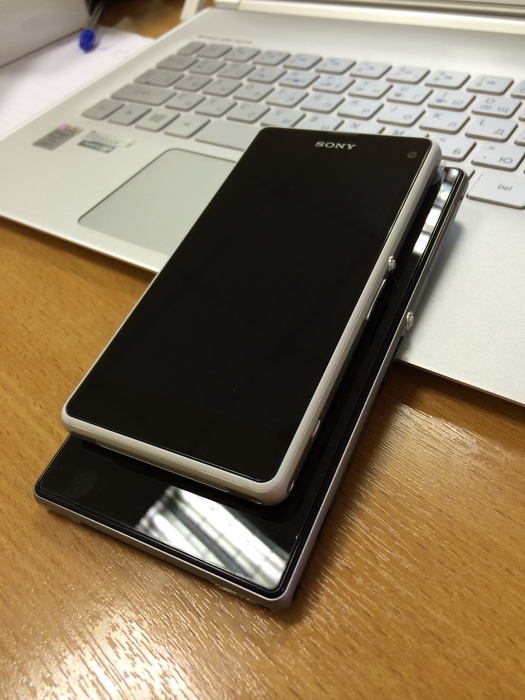
What is unusual about a smartphone? The fact that, despite the reduced size, it saved almost all the characteristics of the flagship Xperia Z1. The only compromise was the screen resolution: 1280x720 pixels instead of 1920x1080. But if you remember that the screen diagonal is only 4.3 inches, there is no need to worry about the reduced resolution, because the difference between Full HD and just HD is not felt at all. This time, Sony used an IPS-matrix with almost perfect viewing angles as compensation.
')
Otherwise, this is a real Z1 in a compact package. In Sony, by the way, they ask not to call in any way a new smartphone Mini, because the word is “spoiled” by other companies, which, under the guise of reduced flagships, sell frankly budget solutions. Z1 Compact is not cheap - they ask for 22 thousand rubles. About how good he is at work, I will write later, but for now, inside, inside, reader!
In terms of dimensions, the Z1 Compact is comparable to the iPhone 5 (an external comparison with a large Z1 can be found here ). The back cover of it, unlike the large model, is not glass, but plastic. This is neither good nor bad, but the cost is likely to be slightly lower. It is held on double-sided tape, and to remove the cover, the device must be warmed with a special hairdryer or held at the soldering station. Master Levchenko and I have chosen the second option.
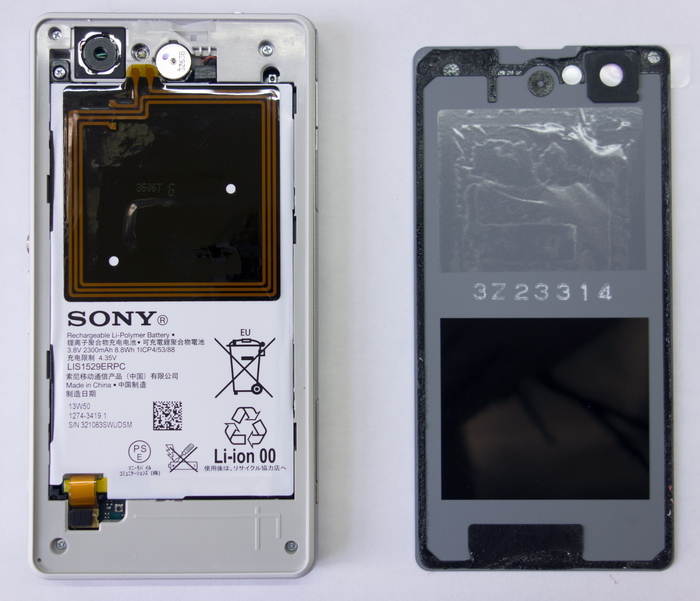
Under the hood, we are met by an NFC antenna and a 2300 mAh battery. This is less than 3000 mAh in Z1, but the screen area has significantly decreased, so less energy is needed for the backlight.

Remove the battery and face the first surprise. In the previous flagships of Sony, access to the e-filling began immediately after removing the cover (gutting the Xperia Z1 can be viewed here ). Here you need to remove the battery, and then another intermediate part, made of plastic. It is part of the antenna.
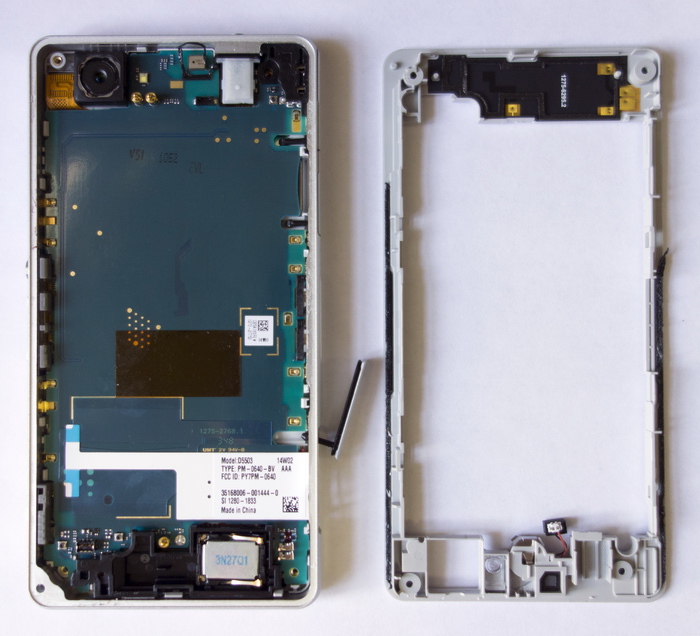
In addition to the bolts, this part is mounted on a double-sided adhesive tape, which ensures the watertightness of the structure. Remove the item without damaging the tape, it is impossible. Therefore, if you decide to do something similar on your own, I recommend to get a supply of this scotch, or accept the fact that after assembling the smartphone you will not be able to dip into the water.
Another surprise was waiting for us when removing the motherboard. All connectors are under it. And if it is relatively easy to snap them off to a blind person, then plugging them back in is already a problem. I remembered how as a child I wound a film on a reel, putting it and my hands inside an old sheepskin coat. To be honest, it was not always the first time. So in this case, the master Levchenko coped only with the third attempt, which, to put it mildly, is uncharacteristic.
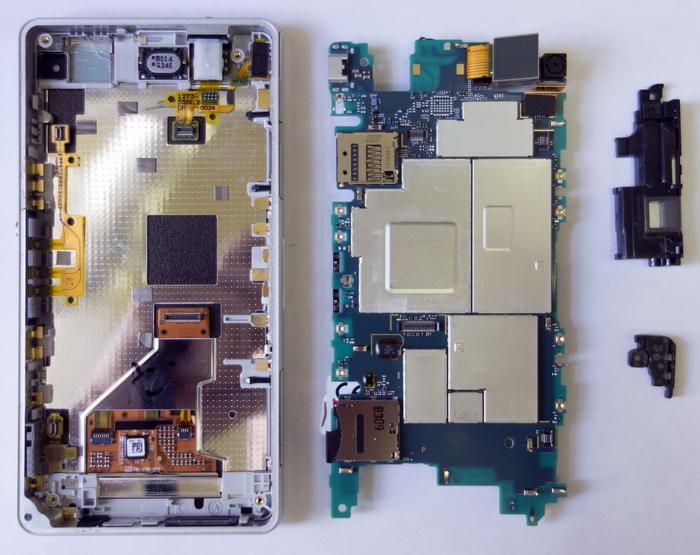
The motherboard on the back side is almost naked, which is no wonder - the battery fits tightly.
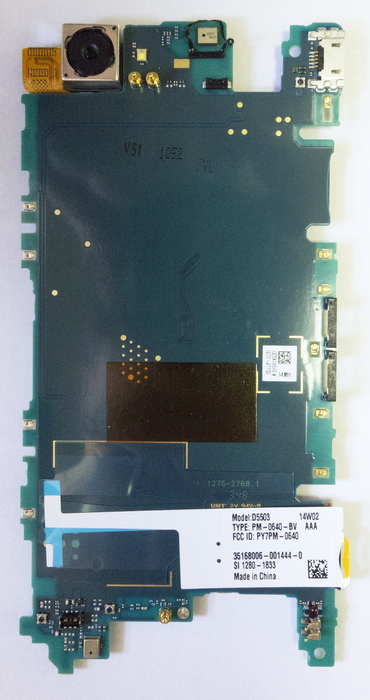
The front part is arranged quite tightly. The chipset is covered with thermopaste from the heart. It may not be as aesthetically pleasing as a thermoscatch, but it is cheap, reliable and practical.
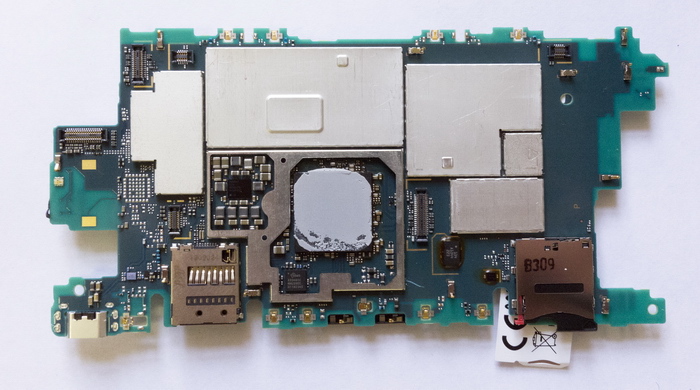
What else should I pay attention to?
Most antennas do not use latches, but contact pads.
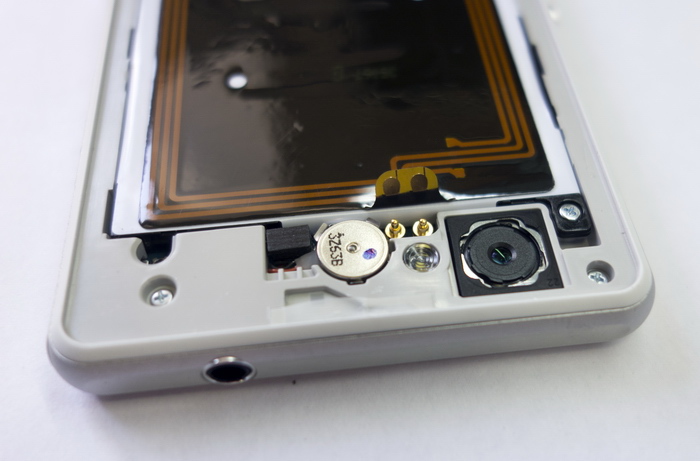
Microphones are only two, so the noise reduction system is unlikely to demonstrate the wonders of efficiency. However, I remember a time when a pair of microphones was considered more than sufficient.
Pleased with the main speaker. This is a classic design, and where only I have not met her. And in the Nokia 5800, and in the Microsoft Surface ... Everything flows, everything changes, but the speaker remains. The film on the back is also for protection against water.
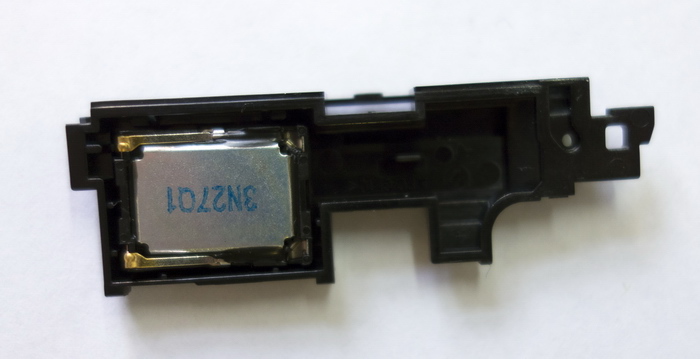

The camera moved to the Z1 Compact from the previous model. They promise that the software in it is improved and it should be removed more decently. But I did not have time to check it yet.
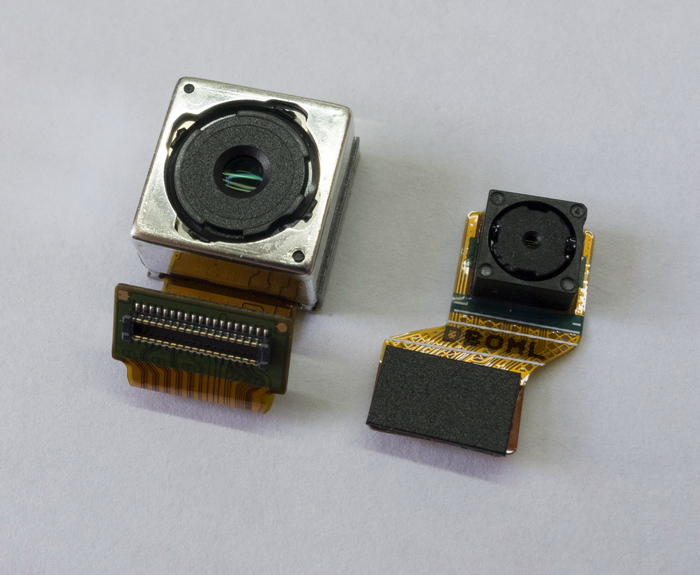
A little surprised by the design of the headphone jack and headset. It is not monolithic, as is usually the case, but folding.


Considering the fact that the nest can be constantly exposed to moisture, this is rather a plus: it is cheaper to replace parts of the structure than everything. But before such a decision we did not have to meet.
What can be summed up?
Placing a powerful filling in a small package is not an easy engineering task. Sony coped with it with dignity, seriously nothing to complain about. However, it became much more difficult to disassemble and especially assemble a smartphone compared to the older version, and it’s definitely not worth doing yourself. Yes, and the workshop can not cope.
Purely psychologically difficult to accept the fact that a small smartphone costs as much as a large one. Therefore, the Z1 Compact was made cheaper - at the start it costs 22 thousand rubles. For the sake of this, the construction was slightly reduced in price (a plastic back cover instead of a glass one), but on the whole, the device produces at least an “expensive” impression than the large Z1. At first sensation, a very correct combination of power and size. But we estimate this in two weeks, carefully reading the Z1 Compact in action.
You can read about my experience of using a smartphone here .
And at parting - a small video recorded in the process of analysis.
PS> The author thanks Alexander Levchenko ( www.tech-town.ru ) for his help in preparing the material.

What is unusual about a smartphone? The fact that, despite the reduced size, it saved almost all the characteristics of the flagship Xperia Z1. The only compromise was the screen resolution: 1280x720 pixels instead of 1920x1080. But if you remember that the screen diagonal is only 4.3 inches, there is no need to worry about the reduced resolution, because the difference between Full HD and just HD is not felt at all. This time, Sony used an IPS-matrix with almost perfect viewing angles as compensation.
')
Otherwise, this is a real Z1 in a compact package. In Sony, by the way, they ask not to call in any way a new smartphone Mini, because the word is “spoiled” by other companies, which, under the guise of reduced flagships, sell frankly budget solutions. Z1 Compact is not cheap - they ask for 22 thousand rubles. About how good he is at work, I will write later, but for now, inside, inside, reader!
In terms of dimensions, the Z1 Compact is comparable to the iPhone 5 (an external comparison with a large Z1 can be found here ). The back cover of it, unlike the large model, is not glass, but plastic. This is neither good nor bad, but the cost is likely to be slightly lower. It is held on double-sided tape, and to remove the cover, the device must be warmed with a special hairdryer or held at the soldering station. Master Levchenko and I have chosen the second option.

Under the hood, we are met by an NFC antenna and a 2300 mAh battery. This is less than 3000 mAh in Z1, but the screen area has significantly decreased, so less energy is needed for the backlight.

Remove the battery and face the first surprise. In the previous flagships of Sony, access to the e-filling began immediately after removing the cover (gutting the Xperia Z1 can be viewed here ). Here you need to remove the battery, and then another intermediate part, made of plastic. It is part of the antenna.

In addition to the bolts, this part is mounted on a double-sided adhesive tape, which ensures the watertightness of the structure. Remove the item without damaging the tape, it is impossible. Therefore, if you decide to do something similar on your own, I recommend to get a supply of this scotch, or accept the fact that after assembling the smartphone you will not be able to dip into the water.
Another surprise was waiting for us when removing the motherboard. All connectors are under it. And if it is relatively easy to snap them off to a blind person, then plugging them back in is already a problem. I remembered how as a child I wound a film on a reel, putting it and my hands inside an old sheepskin coat. To be honest, it was not always the first time. So in this case, the master Levchenko coped only with the third attempt, which, to put it mildly, is uncharacteristic.

The motherboard on the back side is almost naked, which is no wonder - the battery fits tightly.

The front part is arranged quite tightly. The chipset is covered with thermopaste from the heart. It may not be as aesthetically pleasing as a thermoscatch, but it is cheap, reliable and practical.

What else should I pay attention to?
Most antennas do not use latches, but contact pads.

Microphones are only two, so the noise reduction system is unlikely to demonstrate the wonders of efficiency. However, I remember a time when a pair of microphones was considered more than sufficient.
Pleased with the main speaker. This is a classic design, and where only I have not met her. And in the Nokia 5800, and in the Microsoft Surface ... Everything flows, everything changes, but the speaker remains. The film on the back is also for protection against water.


The camera moved to the Z1 Compact from the previous model. They promise that the software in it is improved and it should be removed more decently. But I did not have time to check it yet.

A little surprised by the design of the headphone jack and headset. It is not monolithic, as is usually the case, but folding.


Considering the fact that the nest can be constantly exposed to moisture, this is rather a plus: it is cheaper to replace parts of the structure than everything. But before such a decision we did not have to meet.
What can be summed up?
Placing a powerful filling in a small package is not an easy engineering task. Sony coped with it with dignity, seriously nothing to complain about. However, it became much more difficult to disassemble and especially assemble a smartphone compared to the older version, and it’s definitely not worth doing yourself. Yes, and the workshop can not cope.
Purely psychologically difficult to accept the fact that a small smartphone costs as much as a large one. Therefore, the Z1 Compact was made cheaper - at the start it costs 22 thousand rubles. For the sake of this, the construction was slightly reduced in price (a plastic back cover instead of a glass one), but on the whole, the device produces at least an “expensive” impression than the large Z1. At first sensation, a very correct combination of power and size. But we estimate this in two weeks, carefully reading the Z1 Compact in action.
You can read about my experience of using a smartphone here .
And at parting - a small video recorded in the process of analysis.
PS> The author thanks Alexander Levchenko ( www.tech-town.ru ) for his help in preparing the material.
Source: https://habr.com/ru/post/211687/
All Articles